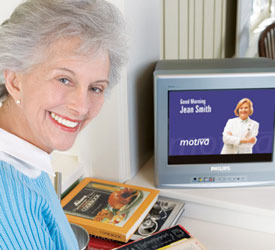by
Brendon Nafziger, DOTmed News Associate Editor | March 30, 2010

The market for
remote health management
products, such as
Philips' Motiva, available
in Europe and
shown here, will reach
almost $4 billion by 2012
The market for devices that help doctors and nurses check up on patients at home will double in the next five years, according to a new analysis.
Cost savings from cutting hospital readmissions for some chronic diseases, gains in efficiency and expanding health access to rural patients will help the market for the devices, known as remote health management (RHM) products, grow 15 percent a year.
That means the industry could grow from an estimated $1.8 billion in 2007 to $3.6 billion in 2012, according to the predictions from Scientia Advisors, a Cambridge, Mass.-based strategy consulting group that prepared the review released on Tuesday.



Ad Statistics
Times Displayed: 137929
Times Visited: 7957 MIT labs, experts in Multi-Vendor component level repair of: MRI Coils, RF amplifiers, Gradient Amplifiers Contrast Media Injectors. System repairs, sub-assembly repairs, component level repairs, refurbish/calibrate. info@mitlabsusa.com/+1 (305) 470-8013
RHM products are used by some of the nation's 10,000 Medicare-approved home health care agencies that are often tapped by health care plans to help monitor patients with chronic diseases. The RHM market is divided into telehealth, such as remote monitoring of vital signs and health coaching, and remote patient monitoring devices, like remote blood pressure cuffs and remote ECGs. Non-networked home care equipment - such as a scale or glucose monitoring stick - isn't included.
Although the smallest slice of the larger $125.3 billion home health management market, it's the seeing the fastest growth, according to Scientia.
And it's not hard to see why. According to Scientia, almost 86 percent of Medicare's costs come from people with chronic conditions.
And much of their costs come from hospital visits and emergency procedures - many of which could be prevented, the theory goes, if doctors could intervene when a patient's health starts to slip, which is exactly what home monitoring proposes to help them do.
"One of the big things is driving down the costs. And with ER visits, if there's a way for us to cut those down, it's going to be a big help," Harry Glorikian, a managing partner of Scientia, tells DOTmed News.
Evidence from clinical studies, largely commissioned by companies that make the devices, is starting to paint a picture of where RHM is, for now, most effective.
"It's basically going after the chronically ill where you can show cost reductions...where you can clearly show there's an effect to having this monitoring system," observes Glorikian.
According to an Avalere Health LLC May 2009 study cited by Scientia, the costs of caring for Medicare patients with chronic diseases like congestive heart failure, obstructive pulmonary disease and diabetes were 43 percent less when using patient monitoring. The two-year study found much of the $1.71 billion in savings came from slashing hospital readmissions, as using remote health monitoring resulted in 24,000 fewer re-hospitalizations than other forms of post-acute care.

